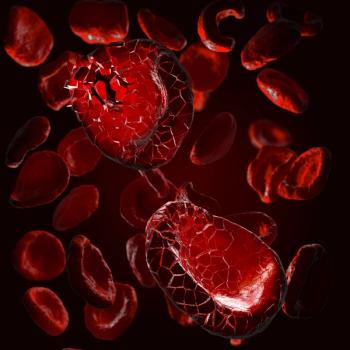
Oncology NEWS International
- Oncology NEWS International Vol 18 No 2
- Volume 18
- Issue 2
Elderly multiple myeloma patients remain responsive to novel therapy teamed with conventional treatment
SAN FRANCISCO-Adding thalidomide to a regimen of bortezomib (Velcade), melphalan, and prednisone nearly doubled the rate of complete responses and improved the overall response rate in elderly patients with newly diagnosed multiple myeloma, according to the results of a phase III trial.
SAN FRANCISCO-Adding thalidomide to a regimen of bortezomib (Velcade), melphalan, and prednisone nearly doubled the rate of complete responses and improved the overall response rate in elderly patients with newly diagnosed multiple myeloma, according to the results of a phase III trial.
Changing the dosing of bortezomib from twice weekly to weekly also significantly reduced the incidence of peripheral neuropathy, said lead investigator Antonio Palumbo, MD, of the University of Torino in Italy, during a presentation at ASH 2008.
Previous trials had indicated that both bortezomib and thalidomide had synergistic effects on the action of the standard chemotherapy regimen of melphalan and prednisone, Dr. Palumbo explained (see “Older multiple myeloma patients show active response to novel agents,” October 2008, page 9).
The phase III Italian trial tested whether the addition of thalidomide and bortezomib to standard chemotherapy could improve outcomes in newly diagnosed myeloma patients over the age of 65. In the study, 393 elderly and newly diagnosed multiple myeloma patients from 58 medical centers in Italy were randomized to one of two regimens:
• VMPT: Nine six-week cycles of bortezomib (1.3 mg/m2), melphalan (9 mg/m2), prednisone (60 mg/m2), and thalidomide (50 mg)
• VMP: Nine six-week cycles of bortezomib (1.3 mg/m2), melphalan (9 mg/m2), prednisone (60 mg/m2) Patients in the VMPT arm also received bortezomib 1.3 mg/m2 every 15 days and thalidomide 50 mg/d as maintenance therapy after the initial treatment. All enrolled patients initially received 1.3 mg/m2 of bortezomib twice weekly, but the protocol was eventually amended to a similar dosage administered once weekly, Dr. Palumbo said.
Initial results indicated that the overall response rate in the VMPT arm was significantly superior to that of the VMP group (55% vs 45%). Thirty-nine percent of patients in the VMPT group and 21% of patients in the VMP arm achieved a complete response (abstract 76).
“While we saw partial responses in the VMPT arm very quickly, after the first or second cycle, complete responses were achieved more slowly through time,” Dr. Palumbo said. “This is an important concept, because it’s possible that lowering the intensity but prolonging treatment could increase the rate of complete responses.”
After a median follow-up of 13.6 months, the two-year progression-free survival (PFS) was 83.9% in the VMPT group and 75.5% in the VMP group. In patients who achieved a complete response aft er induction therapy, the two year PFS was even better: 100% for VMPT and 79% for VMP.
Incidence of grade 3-4 adverse events was similar in both groups, with the most common being neutropenia, thrombocytopenia, peripheral neuropathy, infections, and gastrointestinal complications.
The weekly infusion of bortezomib significantly affected the rate of peripheral neuropathy in both arms of the study. In the VMPT arm, reducing the frequency of bortezomib dosing decreased the rate of peripheral neuropathy from 24% to 6%. In the VMP group, peripheral neuropathy decreased from 14% to 2% with less frequent bortezomib dosing.
“At the same time, the weekly infusion of (bortezomib) did not reduce the incidence of complete response,” Dr. Palumbo said.
Articles in this issue
almost 17 years ago
Consortium advances multidisciplinary program for colon canceralmost 17 years ago
Celator joins leukemia society for phase II trial of CPX-351almost 17 years ago
Genzyme nabs FDA approval for stem cell mobilizing agentalmost 17 years ago
FDA launches pilot safety program for foreign drugsalmost 17 years ago
Radiation oncology society adopts new monikeralmost 17 years ago
Varian places RT units; offers storage systemalmost 17 years ago
Improvements in Pap screenings proposedalmost 17 years ago
New outlook for neuroendocrine canceralmost 17 years ago
Mismatched cord blood stem cells meet need for urgent Rx in acute leukemiaalmost 17 years ago
Risk of transplantrelated mortality doesn’t increase with cord bloodNewsletter
Stay up to date on recent advances in the multidisciplinary approach to cancer.


















































































